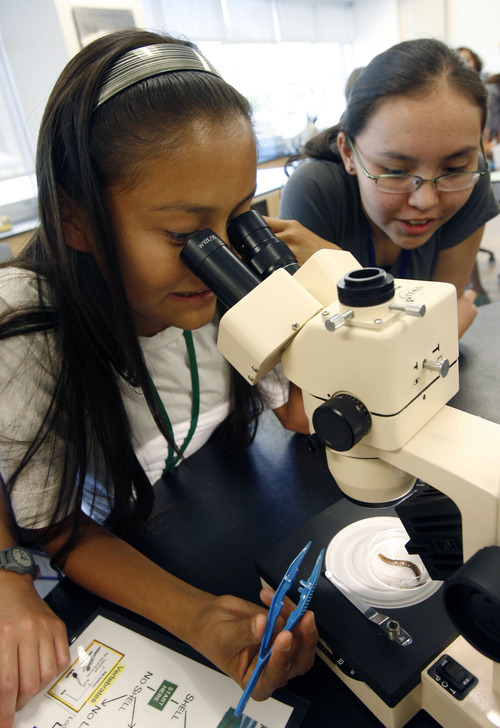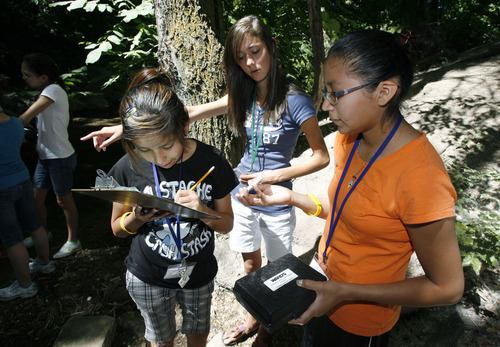This is an archived article that was published on sltrib.com in 2012, and information in the article may be outdated. It is provided only for personal research purposes and may not be reprinted.
The girls stared at it, trying to decide what it was. A slug? A worm? A leech?
Erika Yellowhair, 13, picked up the slimy, wiggly creature with tweezers, repositioning it under the microscope in hopes of getting a closer look.
"It's awesome," said the grinning eighth-grader. "I've seen worse."
It takes far more than a bug to scare the girls at Westminster College's Awe+Sum camp aimed at sparking their interest in science, math and technology. Erika is one of more than 60 attending the camp this summer, including one of nine campers from the Navajo Nation in New Mexico.
Camp leaders hope to show the eighth-grade girls — most of whom are from Utah and some of whom are attending the three-day, overnight camp on scholarships — that college is within their reach and that math, science and technology aren't just for boys.
Nationally, and in Utah, eighth-grade girls lag behind boys on National Assessment of Educational Progress math and science tests. Camp leaders, however, say it doesn't have to be that way.
Emily Johnson, camp coordinator, said girls often start to lose interest in math and science around eighth-grade. Girls sometimes feel societal pressure, she said, not to be interested in math or science because they believe those are for boys and they don't want to be seen as nerds.
"We're removing the social pressure they feel in the classroom," Johnson said. Plus, the camp shows how math and science apply to hands-on, real-world activities.
On Tuesday, the girls split into several groups. One group worked on air traffic control and flight simulations. Another learned computer programming. A third, Erika's group, hiked down to Emigration Creek near Westminster College to measure the water's pH and oxygen levels, and collect organisms (like the bugs).
"It's a lot of hands-on work, which is enjoyable," said Lane Brusa, 13, of Salt Lake City, as she and friends from J.E. Cosgriff Memorial Catholic School in Salt Lake City collected organisms from a large rock they took from the water.
Meanwhile, Erin Todachinnie, 12, of the Navajo Nation, crouched on a rock bridge over a small waterfall to dip a pH testing strip into the water. She matched the colors on the strip to a key to determine the pH level at 7 or neutral.
Erin, who wants to be a marine biologist or chemistry teacher, said science isn't that hard if you know what you're doing. And she said the mud and bugs didn't bother her.
"Those of us who live out in the Navajo Nation don't mind getting dirty because it's very dry out there, and we do a lot of work," Erin said.
Johnson said the camp tries each year to reach out to kids from diverse ethnic and economic backgrounds. This year, she said the camp hopes to expose all the girls, including those from the Navajo Nation, to new opportunities.
Adelaide Johnson, 13, of Midvale, said science could benefit from more females taking part. "Girls have a different point of view than boys do."
Jaimi Butler, coordinator of Westminster's Great Salt Lake Institute and a teacher of the stream class on Tuesday, said it's all about showing girls that a career in math, science or technology is a real option.
"Sometimes it's hard to know what you can do," Butler said, "if you don't know what's out there."
Twitter: @lschencker









